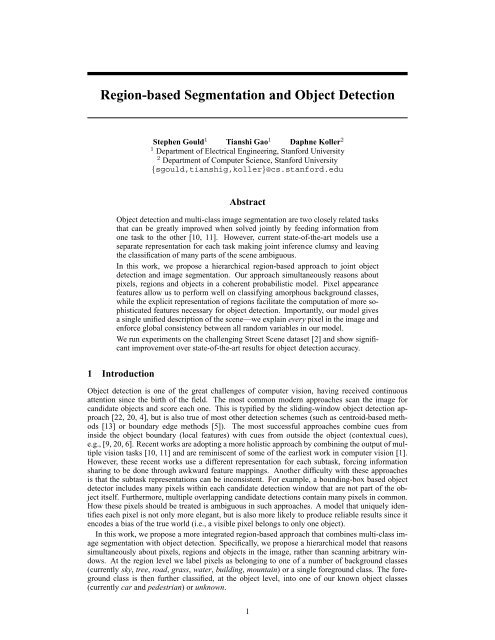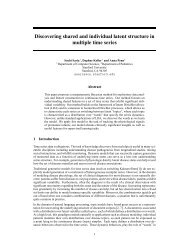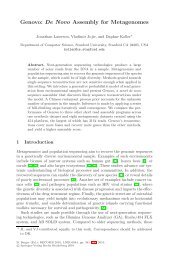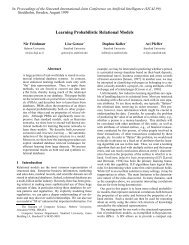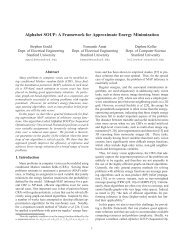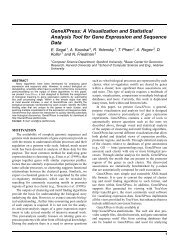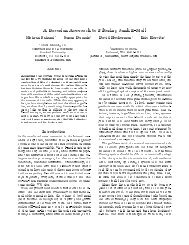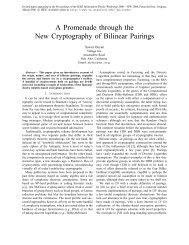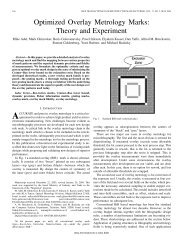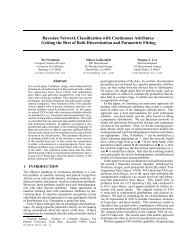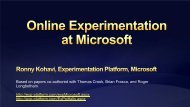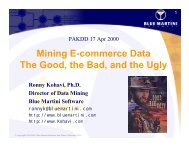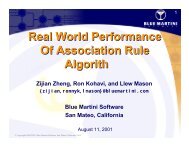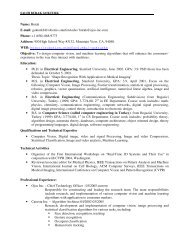Region-based Segmentation and Object Detection - Stanford ...
Region-based Segmentation and Object Detection - Stanford ...
Region-based Segmentation and Object Detection - Stanford ...
Create successful ePaper yourself
Turn your PDF publications into a flip-book with our unique Google optimized e-Paper software.
<strong>Region</strong>-<strong>based</strong> <strong>Segmentation</strong> <strong>and</strong> <strong>Object</strong> <strong>Detection</strong><br />
Stephen Gould 1 Tianshi Gao 1 Daphne Koller 2<br />
1 Department of Electrical Engineering, <strong>Stanford</strong> University<br />
2 Department of Computer Science, <strong>Stanford</strong> University<br />
{sgould,tianshig,koller}@cs.stanford.edu<br />
Abstract<br />
<strong>Object</strong> detection <strong>and</strong> multi-class image segmentation are two closely related tasks<br />
that can be greatly improved when solved jointly by feeding information from<br />
one task to the other [10, 11]. However, current state-of-the-art models use a<br />
separate representation for each task making joint inference clumsy <strong>and</strong> leaving<br />
the classification of many parts of the scene ambiguous.<br />
In this work, we propose a hierarchical region-<strong>based</strong> approach to joint object<br />
detection <strong>and</strong> image segmentation. Our approach simultaneously reasons about<br />
pixels, regions <strong>and</strong> objects in a coherent probabilistic model. Pixel appearance<br />
features allow us to perform well on classifying amorphous background classes,<br />
while the explicit representation of regions facilitate the computation of more sophisticated<br />
features necessary for object detection. Importantly, our model gives<br />
a single unified description of the scene—we explain every pixel in the image <strong>and</strong><br />
enforce global consistency between all r<strong>and</strong>om variables in our model.<br />
We run experiments on the challenging Street Scene dataset [2] <strong>and</strong> show significant<br />
improvement over state-of-the-art results for object detection accuracy.<br />
1 Introduction<br />
<strong>Object</strong> detection is one of the great challenges of computer vision, having received continuous<br />
attention since the birth of the field. The most common modern approaches scan the image for<br />
c<strong>and</strong>idate objects <strong>and</strong> score each one. This is typified by the sliding-window object detection approach<br />
[22, 20, 4], but is also true of most other detection schemes (such as centroid-<strong>based</strong> methods<br />
[13] or boundary edge methods [5]). The most successful approaches combine cues from<br />
inside the object boundary (local features) with cues from outside the object (contextual cues),<br />
e.g., [9, 20, 6]. Recent works are adopting a more holistic approach by combining the output of multiple<br />
vision tasks [10, 11] <strong>and</strong> are reminiscent of some of the earliest work in computer vision [1].<br />
However, these recent works use a different representation for each subtask, forcing information<br />
sharing to be done through awkward feature mappings. Another difficulty with these approaches<br />
is that the subtask representations can be inconsistent. For example, a bounding-box <strong>based</strong> object<br />
detector includes many pixels within each c<strong>and</strong>idate detection window that are not part of the object<br />
itself. Furthermore, multiple overlapping c<strong>and</strong>idate detections contain many pixels in common.<br />
How these pixels should be treated is ambiguous in such approaches. A model that uniquely identifies<br />
each pixel is not only more elegant, but is also more likely to produce reliable results since it<br />
encodes a bias of the true world (i.e., a visible pixel belongs to only one object).<br />
In this work, we propose a more integrated region-<strong>based</strong> approach that combines multi-class image<br />
segmentation with object detection. Specifically, we propose a hierarchical model that reasons<br />
simultaneously about pixels, regions <strong>and</strong> objects in the image, rather than scanning arbitrary windows.<br />
At the region level we label pixels as belonging to one of a number of background classes<br />
(currently sky, tree, road, grass, water, building, mountain) or a single foreground class. The foreground<br />
class is then further classified, at the object level, into one of our known object classes<br />
(currently car <strong>and</strong> pedestrian) or unknown.<br />
1
Our model builds on the scene decomposition model of Gould et al. [7] which aims to decompose<br />
an image into coherent regions by dynamically moving pixel between regions <strong>and</strong> evaluating these<br />
moves relative to a global energy objective. These bottom-up pixel moves result in regions with coherent<br />
appearance. Unfortunately, complex objects such as people or cars are composed of several<br />
dissimilar regions which will not be combined by this bottom-up approach. Our new hierarchical<br />
approach facilitates both bottom-up <strong>and</strong> top-down reasoning about the scene. For example, we<br />
can propose an entire object comprised of multiple regions <strong>and</strong> evaluate this joint move against our<br />
global objective. Thus, our hierarchical model enjoys the best of two worlds: Like multi-class image<br />
segmentation, our model uniquely explains every pixel in the image <strong>and</strong> groups these into semantically<br />
coherent regions. Like object detection, our model uses sophisticated shape <strong>and</strong> appearance<br />
features computed over c<strong>and</strong>idate object locations with precise boundaries. Furthermore, our joint<br />
model over regions <strong>and</strong> objects allows context to be encoded through direct semantic relationships<br />
(e.g., “car” is usually found on “road”).<br />
2 Background <strong>and</strong> Related Work<br />
Our method inherits features from the sliding-window object detector works, such as Torralba et al.<br />
[19] <strong>and</strong> Dalal <strong>and</strong> Triggs [4], <strong>and</strong> the multi-class image segmentation work of Shotton et al. [16].<br />
We further incorporate into our model many novel ideas for improving object detection via scene<br />
context. The innovative works that inspire ours include predicting camera viewpoint for estimating<br />
the real world size of object c<strong>and</strong>idates [12], relating “things” (objects) to nearby “stuff” (regions)<br />
[9], co-occurrence of object classes [15], <strong>and</strong> general scene “gist” [18].<br />
Recent works go beyond simple appearance-<strong>based</strong> context <strong>and</strong> show that holistic scene underst<strong>and</strong>ing<br />
(both geometric [11] <strong>and</strong> more general [10]) can significantly improve performance by<br />
combining related tasks. These works use the output of one task (e.g., object detection) to provide<br />
features for other related tasks (e.g., depth perception). While they are appealing in their simplicity,<br />
current models are not tightly coupled <strong>and</strong> may result in incoherent outputs (e.g., the pixels in<br />
a bounding box identified as “car” by the object detector, may be labeled as “sky” by an image<br />
segmentation task). In our method, all tasks use the same region-<strong>based</strong> representation which forces<br />
consistency between variables. Intuitively this leads to more robust predictions.<br />
The decomposition of a scene into regions to provide the basis for vision tasks exists in some<br />
scene parsing works. Notably, Tu et al. [21] describe an approach for identifying regions in the<br />
scene. Their approach has only be shown to be effective on text <strong>and</strong> faces, leaving much of the<br />
image unexplained. Sudderth et al. [17] relate scenes, objects <strong>and</strong> parts in a single hierarchical<br />
framework, but do not provide an exact segmentation of the image. Gould et al. [7] provides a complete<br />
description of the scene using dynamically evolving decompositions that explain every pixel<br />
(both semantically <strong>and</strong> geometrically). However, the method cannot distinguish between between<br />
foreground objects <strong>and</strong> often leaves them segmented into multiple dissimilar pieces. Our work builds<br />
on this approach with the aim of classifying objects.<br />
Other works attempt to integrate tasks such as object detection <strong>and</strong> multi-class image segmentation<br />
into a single CRF model. However, these models either use a different representation for object<br />
<strong>and</strong> non-object regions [23] or rely on a pixel-level representation [16]. The former does not enforce<br />
label consistency between object bounding boxes <strong>and</strong> the underlying pixels while the latter does not<br />
distinguish between adjacent objects of the same class.<br />
Recent work by Gu et al. [8] also use regions for object detection instead of the traditional slidingwindow<br />
approach. However, unlike our method, they use a single over-segmentation of the image<br />
<strong>and</strong> make the strong assumption that each segment represents a (probabilistically) recognizable object<br />
part. Our method, on the other h<strong>and</strong>, assembles objects (<strong>and</strong> background regions) using segments<br />
from multiple different over-segmentations. The multiple over-segmentations avoids errors<br />
made by any one segmentation. Furthermore, we incorporate background regions which allows us to<br />
eliminate large portions of the image thereby reducing the number of component regions that need<br />
to be considered for each object.<br />
Liu et al. [14] use a non-parametric approach to image labeling by warping a given image onto a<br />
large set of labeled images <strong>and</strong> then combining the results. This is a very effective approach since it<br />
scales easily to a large number of classes. However, the method does not attempt to underst<strong>and</strong> the<br />
scene semantics. In particular, their method is unable to break the scene into separate objects (e.g., a<br />
row of cars will be parsed as a single region) <strong>and</strong> cannot capture combinations of classes not present<br />
in the training set. As a result, the approach performs poorly on most foreground object classes.<br />
2
3 <strong>Region</strong>-<strong>based</strong> Model for <strong>Object</strong> <strong>Detection</strong><br />
We now present an overview of our joint object detection <strong>and</strong> scene segmentation model. This model<br />
combines scene structure <strong>and</strong> semantics in a coherent energy function.<br />
3.1 Energy Function<br />
Our model builds on the work of Gould et al. [7] which aims to decompose a scene into a number (K)<br />
of semantically consistent regions. In that work, each pixel p in the image I belongs to exactly one<br />
region, identified by its region-correspondence variable Rp ∈ {1,...,K}. The r-th region is then<br />
simply the set of pixels Pr whose region-correspondence variable equals r, i.e., Pr = {p : Rp = r}.<br />
In our notation we will always use p <strong>and</strong> q to denote pixels, r <strong>and</strong> s to denote regions, <strong>and</strong> o to denote<br />
objects. Double indices indicate pairwise terms between adjacent entities (e.g., pq or rs).<br />
<strong>Region</strong>s, while visually coherent, may not encompass entire objects. Indeed, in the work of Gould<br />
et al. [7] foreground objects tended to be over-segmented into multiple regions. We address this deficiency<br />
by allowing an object to be composed of many regions (rather than trying to force dissimilar<br />
regions to merge). The object to which a region belongs is denoted by its object-correspondence<br />
variable Or ∈ {∅,1,...,N}. Some regions, such as background, do not belong to any object<br />
which we denote by Or = ∅. Like regions, the set of pixels that comprise the o-th object is denoted<br />
by Po = <br />
r:Or=o Pr. Currently, we do not allow a single region or object to be composed of<br />
multiple disconnected components.<br />
R<strong>and</strong>om variables are associated with the various entities (pixels, regions <strong>and</strong> objects) in our<br />
model. Each pixel has a local appearance feature vector αp ∈ Rn (see [7]). Each region has an<br />
appearance variable Ar that summarizes the appearance of the region as a whole, a semantic class<br />
label Sr (such as “road” or “foreground object”), <strong>and</strong> an object-correspondence variable Or. Each<br />
object, in turn, has an associated object class label Co (such as “car” or “pedestrian”). The final<br />
component in our model is the horizon which captures global geometry information. We assume<br />
that the image was taken by a camera with horizontal axis parallel to the ground <strong>and</strong> model the<br />
horizon vhz ∈ [0,1] as the normalized row in the image corresponding to its location. We quantize<br />
vhz into the same number of rows as the image.<br />
We combine the variables in our model into a single coherent energy function that captures the<br />
structure <strong>and</strong> semantics of the scene. The energy function includes terms for modeling the location<br />
of the horizon, region label preferences, region boundary quality, object labels, <strong>and</strong> contextual relationships<br />
between objects <strong>and</strong> regions. These terms are described in detail below. The combined<br />
energy function E(R,S,O,C,v hz | I,θ) has the form:<br />
E = ψ hz (v hz ) + <br />
ψ reg<br />
r (Sr,v hz ) + <br />
ψ bdry<br />
ψ obj<br />
r<br />
r,s<br />
rs + <br />
o<br />
o (Co,v hz ) + <br />
o,r<br />
ψ ctxt<br />
or (Co,Sr) (1)<br />
where for notational clarity the subscripts on the factors indicate that they are functions of the pixels<br />
(appearance <strong>and</strong> shape) belonging to the regions, i.e., ψ reg<br />
r is also a function of Pr, etc. It is assumed<br />
that all terms are conditioned on the observed image I <strong>and</strong> model parameters θ. The summation<br />
over context terms includes all ordered pairs of adjacent objects <strong>and</strong> regions, while the summation<br />
over boundary terms is over unordered pairs of regions. An illustration of the variables in the energy<br />
function is shown in Figure 1.<br />
The first three energy terms are adapted from the model of [7]. We briefly review them here:<br />
Horizon term. The ψhz term captures the a priori location of the horizon in the scene <strong>and</strong>, in our<br />
model, is implemented as a log-gaussian ψhz (vhz ) = −log N(v hz ;µ,σ2 ) with parameters µ <strong>and</strong> σ<br />
learned from labeled training images.<br />
Knowing the location of the horizon allows us to compute the world height of an object in the<br />
scene. Using the derivation from Hoiem et al. [12], it can be shown that the height yk of an object<br />
(or region) in the scene can be approximated as yk ≈ h vt−vb where h is the height of the camera<br />
vhz−vb origin above the ground, <strong>and</strong> vt <strong>and</strong> vb are the row of the top-most <strong>and</strong> bottom-most pixels in the<br />
object/region, respectively. In our current work, we assume that all images were taken from the<br />
as a feature in our region <strong>and</strong> object terms.<br />
same height above the ground, allowing us to use vt−vb<br />
v hz −vb<br />
<strong>Region</strong> term. The region term ψ reg in our energy function captures the preference for a region<br />
to be assigned different semantic labels (currently sky, tree, road, grass, water, building, mountain,<br />
foreground). For convenience we include the v hz variable in this term to provide rough geometry<br />
information. If a region is associated with an object, then we constrain the assignment of its class<br />
label to foreground (e.g., a “sky” region cannot be part of a “car” object).<br />
3
Procedure SceneInference<br />
Generate over-segmentation dictionary Ω<br />
Initialize Rp using any of the over-segmentations<br />
Repeat until convergence<br />
Phase 1:<br />
Propose a pixel move {Rp : p ∈ ω} ← r<br />
Update region <strong>and</strong> boundary features<br />
Run inference over regions S <strong>and</strong> v hz<br />
Phase 2:<br />
Propose a pixel {Rp} ← r or region move {Or} ← o<br />
Update region, boundary <strong>and</strong> object features<br />
Run inference over regions <strong>and</strong> objects (S,C) <strong>and</strong> v hz<br />
Compute total energy E<br />
If (E < E min ) then<br />
Accept move <strong>and</strong> set E min = E<br />
Else reject move<br />
Figure 1: Illustration of the entities in our model (left) <strong>and</strong> inference algorithm (right). See text for details.<br />
More formally, let Nr be the number of pixels in region r, i.e., Nr = <br />
p 1{Rp = r}, <strong>and</strong> let<br />
φr : Pr,v hz , I ↦→ R n denote the features for the r-th region. The region term is then<br />
ψ reg<br />
r (Sr,v hz ) =<br />
∞ if Or = ∅ <strong>and</strong> Sr = foreground<br />
−η reg Nr log σ (Sr | φr;θ reg ) otherwise<br />
where σ(·) is the multi-class logit σ(y | x;θ) = exp{θT y x}<br />
n<br />
P<br />
y<br />
′ exp<br />
θ T<br />
y ′x<br />
(2)<br />
o <strong>and</strong> η reg is the relative weight of the<br />
region term versus the other terms in the model.<br />
Boundary term. The term ψ bdry penalizes two adjacent regions with similar appearance or lack<br />
of boundary contrast. This helps to merge coherent pixels into a single region. We combine two<br />
metrics in this term: the first captures region similarity as a whole, the second captures contrast along<br />
the common boundary between the regions. Specifically, let d (x,y;S) = (x − y) T S −1 (x − y)<br />
denote the Mahalanobis distance between vectors x <strong>and</strong> y, <strong>and</strong> Ers be the set of pixels along the<br />
boundary. Then the boundary term is<br />
ψ bdry<br />
rs = η bdry<br />
A · |Ers|<br />
1 −<br />
· e 2 d(Ar,As;ΣA)2<br />
+ η bdry<br />
α<br />
<br />
(p,q)∈Ers<br />
1 −<br />
e 2 d(αp,αq;Σα)2<br />
where the ΣA <strong>and</strong> Σα are the image-specific pixel appearance covariance matrix computed over all<br />
pixels <strong>and</strong> neighboring pixels, respectively. In our experiments we restrict ΣA to be diagonal <strong>and</strong> set<br />
Σα = βI with β = E αp − αq2 as in Shotton et al. [16]. The parameters η bdry<br />
A <strong>and</strong> ηbdry α encode<br />
the trade-off between the region similarity <strong>and</strong> boundary contrast terms <strong>and</strong> weight them against the<br />
other terms in the energy function (Equation 1).<br />
Note that the boundary term does not include semantic class or object information. The term<br />
purely captures segmentation coherence in terms of appearance.<br />
<strong>Object</strong> term. Going beyond the model in [7], we include object terms ψobj in our energy function<br />
that score the likelihood of a group of regions being assigned a given object label. We currently<br />
classify objects as either car, pedestrian or unknown. The unknown class includes objects like trash<br />
cans, street signs, telegraph poles, traffic cones, bicycles, etc. Like the region term, the object term<br />
is defined by a logistic function that maps object features φo : Po,v hz , I ↦→ Rn to probability of<br />
each object class. However, since our region layer already identifies foreground regions, we would<br />
like our energy to improve only when we recognize known object classes. We therefore bias the<br />
object term to give zero contribution to the energy for the class unknown. 1 Formally we have<br />
ψ obj<br />
n (Co,v hz ) = −η obj <br />
No log σ Co | φo;θ obj − log σ unknown | φo;θ obj<br />
(4)<br />
where No is the number of pixels belonging to the object.<br />
Context term. Intuitively, contextual information which relates objects to their local background<br />
can improve object detection. For example, Heitz <strong>and</strong> Koller [9] showed that detection rates improve<br />
by relating “things” (objects) to “stuff” (background). Our model has a very natural way of<br />
1 This results in the technical condition of allowing Or to take the value ∅ for unknown foreground regions<br />
without affecting the energy.<br />
4<br />
(3)
encoding such relationships through pairwise energy terms between objects Co <strong>and</strong> regions Sr. We<br />
do not encode contextual relationships between region classes (i.e., Sr <strong>and</strong> Ss) since these rarely<br />
help. 2 Contextual relationships between foreground objects (i.e., Co <strong>and</strong> Cm) may be beneficial<br />
(e.g., people found on bicycles), but are not considered in this work. Formally, the context term is<br />
ψ ctxt<br />
or (Co,Sr) = −η ctxt log σ Co × Sr | φor;θ ctxt<br />
(5)<br />
where φor : (Po, Pr, I) ↦→ Rn is a pairwise feature vector for object o <strong>and</strong> region r, σ(·) is the<br />
multi-class logit, <strong>and</strong> ηctxt weights the strength of the context term relative to other terms in the<br />
energy function. Since the pairwise context term is between objects <strong>and</strong> (background) regions it<br />
grows linearly with the number of object classes. This has a distinct advantage over approaches<br />
which include a pairwise term between all classes resulting in quadratic growth.<br />
3.2 <strong>Object</strong> Detectors<br />
Performing well at object detection requires more than simple region appearance features. Indeed,<br />
the power of state-of-the-art object detectors is their ability to model localized appearance <strong>and</strong> general<br />
shape characteristics of an object class. Thus, in addition to raw appearance features, we append<br />
to our object feature vector φo features derived from such object detection models. We discuss two<br />
methods for adapting state-of-the-art object detector technologies for this purpose.<br />
In the first approach, we treat the object detector as a black-box that returns a score per (rectangular)<br />
c<strong>and</strong>idate window. However, recall that an object in our model is defined by a contiguous<br />
set of pixels Po, not a rectangular window. In the black-box approach, we naively place a bounding<br />
box (at the correct aspect ratio) around these pixels <strong>and</strong> classify the entire contents of the box. To<br />
make classification more robust we search c<strong>and</strong>idate windows in a small neighborhood (defined over<br />
scale <strong>and</strong> position) around this bounding box, <strong>and</strong> take as our feature the output of highest scoring<br />
window. In our experiments we test this approach using the HOG detector of Dalal <strong>and</strong> Triggs [4]<br />
which learns a linear SVM classifier over feature vectors constructed by computing histograms of<br />
gradient orientations in fixed-size overlapping cells within the c<strong>and</strong>idate window.<br />
Note that in the above black-box approach many of the pixels within the bounding box are not<br />
actually part of the object (consider, for example, an L-shaped region). A better approach is to<br />
mask out all pixels not belonging to the the object. In our implementation, we use a soft mask that<br />
attenuates the intensity of pixels outside the object <strong>based</strong> on their distance to the object boundary (see<br />
Figure 2). This has the dual advantage of preventing hard edge artifacts <strong>and</strong> being less sensitive to<br />
segmentation errors. The masked window is used at both training <strong>and</strong> test time. In our experiments<br />
we test this more integrated approach using the patch-<strong>based</strong> features of Torralba et al. [19, 20].<br />
Here features are extracted by matching small rectangular patches at various locations within the<br />
masked window <strong>and</strong> combining these weak responses using boosting. <strong>Object</strong> appearance <strong>and</strong> shape<br />
are captured by operating on both the original (intensity) image <strong>and</strong> the edge-filtered image.<br />
For both approaches, we append the score (for each object) from the object detection classifiers—<br />
linear SVM or boosted decision trees—to the object feature vector φo.<br />
(a) full window (b) hard region mask (c) hard window (d) soft region mask (e) soft window<br />
Figure 2: Illustration of soft mask for proposed object regions.<br />
An important parameter for sliding-window detectors is the base scale at which features are extracted.<br />
Scale-invariance is achieved by successively down-sampling the image. Below the basescale,<br />
feature matching becomes inaccurate, so most detectors will only find objects above some<br />
minimum size. Clearly there exists a trade-off between the desire to detect small objects, feature<br />
quality, <strong>and</strong> computational cost. To reduce the computational burden of running our model on<br />
high-resolution images while still being able to identify small objects, we employ a multi-scale approach.<br />
Here we run our scene decomposition algorithm on a low-resolution (320 × 240) version<br />
of the scene, but extract features from the original high-resolution version. That is, when we extract<br />
object-detector features we map the object pixels Po onto the original image <strong>and</strong> extract our features<br />
at the higher resolution.<br />
2 The most informative region-to-region relationship is that sky tends to be above ground (road, grass, or<br />
water). This information is already captured by including the horizon in our region term.<br />
5
4 Inference <strong>and</strong> Learning<br />
We now describe how we perform inference <strong>and</strong> learn the parameters of our energy function.<br />
4.1 Inference<br />
We use a modified version of the hill-climbing inference algorithm described in Gould et al. [7],<br />
which uses multiple over-segmentations to propose large moves in the energy space. An overview<br />
of this procedure is shown in the right of Figure 1. We initialize the scene by segmenting the<br />
image using an off-the-shelf unsupervised segmentation algorithm (in our experiments we use meanshift<br />
[3]). We then run inference using a two-phased approach.<br />
In the first phase, we want to build up a good set of initial regions before trying to classify them as<br />
objects. Thus we remove the object variables O <strong>and</strong> C from the model <strong>and</strong> artificially increase the<br />
boundary term weights (η bdry<br />
α <strong>and</strong> η bdry<br />
A ) to promote merging. In this phase, the algorithm behaves<br />
exactly as in [7] by iteratively proposing re-assignments of pixels to regions (variables R) <strong>and</strong> recomputes<br />
the optimal assignment to the remaining variables (S <strong>and</strong> vhz ). If the overall energy for the<br />
new configuration is lower, the move is accepted, otherwise the previous configuration is restored<br />
<strong>and</strong> the algorithm proposes a different move. The algorithm proceeds until no further reduction in<br />
energy can be found after exhausting all proposal moves from a pre-defined set (see Section 4.2).<br />
In the second phase, we anneal the boundary term weights <strong>and</strong> introduce object variables over<br />
all foreground regions. We then iteratively propose merges <strong>and</strong> splits of objects (variables O) as<br />
well as high-level proposals (see Section 4.2 below) of new regions generated from sliding-window<br />
object c<strong>and</strong>idates (affecting both R <strong>and</strong> O). After a move is proposed, we recompute the optimal<br />
assignment to the remaining variables (S, C <strong>and</strong> vhz ). Again, this process repeats until the energy<br />
cannot be reduced by any of the proposal moves.<br />
Since only part of the scene is changing during any iteration we only need to recompute the<br />
features <strong>and</strong> energy terms for the regions affected by a move. However, inference is still slow given<br />
the sophisticated features that need to be computed <strong>and</strong> the large number of moves considered.<br />
To improve running time, we leave the context terms ψctxt out of the model until the last iteration<br />
through the proposal moves. This allows us to maximize each region term independently during<br />
each proposal step—we use an iterated conditional modes (ICM) update to optimize vhz after the<br />
region labels have been inferred. After introducing the context term, we use max-product belief<br />
propagation to infer the optimal joint assignment to S <strong>and</strong> C. Using this approach we can process<br />
an image in under five minutes.<br />
4.2 Proposal Moves<br />
We now describe the set of pixel <strong>and</strong> region proposal moves considered by our algorithm. These<br />
moves are relative to the current best scene decomposition <strong>and</strong> are designed to take large steps in<br />
the energy space to avoid local minima. As discussed above, each move is accepted if it results in a<br />
lower overall energy after inferring the optimal assignment for the remaining variables.<br />
The main set of pixel moves are described in [7] but briefly repeated here for completeness.<br />
The most basic move is to merge two adjacent regions. More sophisticated moves involve local<br />
re-assignment of pixels to neighboring regions. These moves are proposed from a pre-computed<br />
dictionary of image segments Ω. The dictionary is generated by varying the parameters of an unsupervised<br />
over-segmentation algorithm (in our case mean-shift [3]) <strong>and</strong> adding each segment ω to<br />
the dictionary. During inference, these segments are used to propose a re-assignment of all pixels<br />
in the segment to a neighboring region or creation of new region. These bottom-up proposal moves<br />
work well for background classes, but tend to result in over-segmented foreground classes which<br />
have heterogeneous appearance, for example, one would not expect the wheels <strong>and</strong> body of a car to<br />
be grouped together by a bottom-up approach.<br />
An analogous set of moves can be used for merging two adjacent objects or assigning regions<br />
to objects. However, if an object is decomposed into multiple regions, this bottom-up approach is<br />
problematic as multiple such moves may be required to produce a complete object. When performed<br />
independently, these moves are unlikely to improve the energy. We get around this difficulty by<br />
introducing a new set of powerful top-down proposal moves <strong>based</strong> on object detection c<strong>and</strong>idates.<br />
Here we use pre-computed c<strong>and</strong>idates from a sliding-window detector to propose new foreground<br />
regions with corresponding object variable. Instead of proposing the entire bounding-box from the<br />
detector, we propose the set of intersecting segments (from our segmentation dictionary Ω) that are<br />
fully contained within the bounding-box in a single move.<br />
6
EXPERIMENT CARS PED.<br />
Patch baseline 0.40 0.15<br />
HOG baseline 0.35 0.37<br />
Patch RB (w/o cntxt) 0.55 0.22<br />
Patch RB (full model) 0.56 0.21<br />
HOG RB (w/o cntxt) 0.58 0.35<br />
HOG RB (full model) 0.57 0.35<br />
Figure 3: PR curves for car (left) <strong>and</strong> pedestrian (right) detection on the Street Scene dataset [2]. The table<br />
shows 11-pt average precision for variants of the baseline sliding-window <strong>and</strong> our region-<strong>based</strong> (RB) approach.<br />
4.3 Learning<br />
We learn the parameters of our model from labeled training data in a piecewise fashion. First, the<br />
individual terms are learned using the maximum-likelihood objective for the subset of variables<br />
within each term. The relative weights (η reg , η obj , etc.) between the terms are learned through crossvalidation<br />
on a subset of the training data. Boosted pixel appearance features (see [7]) <strong>and</strong> object<br />
detectors are learned separately <strong>and</strong> their output provided as input features to the combined model.<br />
For both the base object detectors <strong>and</strong> the parameters of the region <strong>and</strong> object terms, we use a<br />
closed-loop learning technique where we first learn an initial set of parameters from training data.<br />
We then run inference on our training set <strong>and</strong> record mistakes made by the algorithm (false-positives<br />
for object detection <strong>and</strong> incorrect moves for the full algorithm). We augment the training data with<br />
these mistakes <strong>and</strong> re-train. This process gives a significant improvement to the final results.<br />
5 Experiments<br />
We conduct experiments on the challenging Street Scene dataset [2]. This is a dataset consisting of<br />
3547 high-resolution images of urban environments. We rescaled the images to 320 × 240 before<br />
running our algorithm. The dataset comes with h<strong>and</strong>-annotated region labels <strong>and</strong> object boundaries.<br />
However, the annotations use rough overlapping polygons, so we used Amazon’s Mechanical Turk<br />
to improve the labeling of the background classes only. We kept the original object polygons to be<br />
consistent with other results on this dataset.<br />
We divided the dataset into five folds—the first fold (710 images) was used for testing <strong>and</strong> the<br />
remaining four used for training. The multi-class image segmentation component of our model<br />
achieves an overall pixel-level accuracy of 84.2% across the eight semantic classes compared to<br />
83.0% for the pixel-<strong>based</strong> baseline method described in [7]. More interesting was our object detection<br />
performance. The test set contained 1183 cars <strong>and</strong> 293 pedestrians with average size of 86 ×48<br />
<strong>and</strong> 22 × 49 pixels, respectively. Many objects are occluded making this a very difficult dataset.<br />
Since our algorithm produces MAP estimation for the scene we cannot simply generate a<br />
precision-recall curve by varying the object classifier threshold as is usual for reporting object detection<br />
results. Instead we take the max-marginals for each Cn variable at convergence of our algorithm<br />
<strong>and</strong> sweep over thresholds for each object separately to generate a curve. An attractive aspect of this<br />
approach is that our method does not have overlapping c<strong>and</strong>idates <strong>and</strong> hence does not require arbitrary<br />
post-processing such as non-maximal suppression of sliding-window detections.<br />
Our results are shown in Figure 3. We also include a comparison to two baseline sliding-window<br />
approaches. Our method significantly improves over the baselines for car detection. For pedestrian<br />
detection, our method shows comparable performance to the HOG baseline which has been specifically<br />
engineered for this task. Notice that our method does not achieve 100% recall (even at low<br />
precision) due to the curves being generated from the MAP assignment in which pixels have already<br />
been grouped into regions. Unlike the baselines, this forces only one c<strong>and</strong>idate object per region.<br />
However, by trading-off the strength (<strong>and</strong> hence operating point) of the energy terms in our model<br />
we can increase the maximum recall for a given object class (e.g., by increasing the weight of the<br />
object term by a factor of 30 we were able to increase pedestrian recall from 0.556 to 0.673).<br />
Removing the pairwise context term does not have a significant affect on our results. This is<br />
due to the encoding of semantic context through the region term <strong>and</strong> the fact that all images were<br />
of urban scenes. However, we believe that on a dataset with more varied backgrounds (e.g., rural<br />
scenes) context would play a more important role.<br />
We show some example output from our algorithm in Figure 4. The first row shows the original<br />
image (left) together with annotated regions <strong>and</strong> objects (middle-left), regions (middle-right) <strong>and</strong><br />
predicted horizon (right). Notice how multiple regions get grouped together into a single object.<br />
The remaining rows show a selection of results (image <strong>and</strong> annotated output) from our method.<br />
7
Figure 4: Qualitative results from our experiments. Top row shows original image, annotated regions <strong>and</strong><br />
objects, region boundaries, <strong>and</strong> predicted horizon. Other examples show original image (left) <strong>and</strong> overlay<br />
colored by semantic class <strong>and</strong> detected objects (right).<br />
6 Discussion<br />
In this paper we have presented a hierarchical model for joint object detection <strong>and</strong> image segmentation.<br />
Our novel approach overcomes many of the problems associated with trying to combine related<br />
vision tasks. Importantly, our method explains every pixel in the image <strong>and</strong> enforces consistency between<br />
r<strong>and</strong>om variables from different tasks. Furthermore, our model is encapsulated in a modular<br />
energy function which can be easily analyzed <strong>and</strong> improved as new computer vision technologies<br />
become available.<br />
One of the difficulties in our model is learning the trade-off between energy terms—too strong a<br />
boundary penalty <strong>and</strong> all regions will be merged together, while too weak a penalty <strong>and</strong> the scene<br />
will be split into too many segments. We found that a closed-loop learning regime where mistakes<br />
from running inference on the training set are used to increase the diversity of training examples<br />
made a big difference to performance.<br />
Our work suggests a number of interesting directions for future work. First, our greedy inference<br />
procedure can be replaced with a more sophisticated approach that makes more global steps. More<br />
importantly, our region-<strong>based</strong> model has the potential for providing holistic unified underst<strong>and</strong>ing<br />
of an entire scene. This has the benefit of eliminating many of the implausible hypotheses that<br />
plague current computer vision algorithms. Furthermore, by clearly delineating what is recognized,<br />
our framework directly present hypotheses for objects that are currently unknown providing the<br />
potential for increasing our library of characterized objects using a combination of supervised <strong>and</strong><br />
unsupervised techniques.<br />
Acknowledgments. This work was supported by the NSF under grant IIS 0917151, MURI contract<br />
N000140710747, <strong>and</strong> The Boeing Company. We thank Pawan Kumar <strong>and</strong> Ben Packer for helpful discussions.<br />
8
References<br />
[1] H.G. Barrow <strong>and</strong> J.M. Tenenbaum. Computational vision. IEEE, 1981.<br />
[2] S. Bileschi <strong>and</strong> L. Wolf. A unified system for object detection, texture recognition, <strong>and</strong> context analysis<br />
<strong>based</strong> on the st<strong>and</strong>ard model feature set. In BMVC, 2005.<br />
[3] D. Comaniciu <strong>and</strong> P. Meer. Mean shift: A robust approach toward feature space analysis. PAMI, 2002.<br />
[4] N. Dalal <strong>and</strong> B. Triggs. Histograms of oriented gradients for human detection. In CVPR, 2005.<br />
[5] V. Ferrari, L. Fevrier, F. Jurie, <strong>and</strong> C. Schmid. Groups of adjacent contour segments for object detection.<br />
PAMI, 2008.<br />
[6] M. Fink <strong>and</strong> P. Perona. Mutual boosting for contextual inference. In NIPS, 2003.<br />
[7] Stephen Gould, Rick Fulton, <strong>and</strong> Daphne Koller. Decompsing a scene into geometric <strong>and</strong> semantically<br />
consistent regions. In ICCV, 2009.<br />
[8] C. Gu, J. J. Lim, P. Arbelaez, <strong>and</strong> J. Malik. Recognition using regions. In CVPR, 2009.<br />
[9] G. Heitz <strong>and</strong> D. Koller. Learning spatial context: Using stuff to find things. In ECCV, 2008.<br />
[10] G. Heitz, S. Gould, A. Saxena, <strong>and</strong> D. Koller. Cascaded classification models: Combining models for<br />
holistic scene underst<strong>and</strong>ing. In NIPS, 2008.<br />
[11] D. Hoiem, A. A. Efros, <strong>and</strong> M. Hebert. Closing the loop on scene interpretation. CVPR, 2008.<br />
[12] D. Hoiem, A. A. Efros, <strong>and</strong> M. Hebert. Putting objects in perspective. IJCV, 2008.<br />
[13] B. Leibe, A. Leonardis, <strong>and</strong> B. Schiele. Combined object categorization <strong>and</strong> segmentation with an implicit<br />
shape model. In ECCV, 2004.<br />
[14] C. Liu, J. Yuen, <strong>and</strong> A. Torralba. Nonparametric scene parsing: Label transfer via dense scene alignment.<br />
In CVPR, 2009.<br />
[15] A. Rabinovich, A. Vedaldi, C. Galleguillos, E. Wiewiora, <strong>and</strong> S. Belongie. <strong>Object</strong>s in context. In ICCV,<br />
2007.<br />
[16] J. Shotton, J. Winn, C. Rother, <strong>and</strong> A. Criminisi. TextonBoost: Joint appearance, shape <strong>and</strong> context<br />
modeling for multi-class object recognition <strong>and</strong> segmentation. In ECCV, 2006.<br />
[17] E. Sudderth, A. Torralba, W. Freeman, <strong>and</strong> A. Willsky. Describing visual scenes using transformed objects<br />
<strong>and</strong> parts. In IJCV, 2007.<br />
[18] A. Torralba, K. P. Murphy, W. T. Freeman, <strong>and</strong> M. A. Rubin. Context-<strong>based</strong> vision system for place <strong>and</strong><br />
object recognition, 2003.<br />
[19] A. Torralba, K. Murphy, <strong>and</strong> W. Freeman. Sharing features: efficient boosting procedures for multiclass<br />
object detection. In CVPR, 2004.<br />
[20] A. Torralba, K. Murphy, <strong>and</strong> W. Freeman. Contextual models for object detection using boosted r<strong>and</strong>om<br />
fields. In NIPS, 2004.<br />
[21] Z. Tu, X. Chen, A. L. Yuille, <strong>and</strong> S.-C. Zhu. Image parsing: Unifying segmentation, detection, <strong>and</strong><br />
recognition. In ICCV, 2003.<br />
[22] P. Viola <strong>and</strong> M. J. Jones. Robust real-time face detection. IJCV, 2004.<br />
[23] C. Wojek <strong>and</strong> B. Schiele. A dynamic conditional r<strong>and</strong>om field model for joint labeling of object <strong>and</strong> scene<br />
classes. In ECCV, 2008.<br />
9


